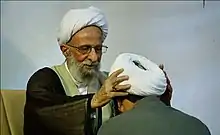Knocking turban
Ammāmeparāni (Persian:عمامهپرانی; "turban throwing") or "knocking off the turban" refers to a protest action by Iranians in which they throw the turban off the head of a mullah (Persian: Akhund) in order to express their disgust with the Shia clergy and therefore insult it.[1] During the Mahsa Amini protests in Iran of 2022, people would take videos while knocking off turbans and publish them on social media.[2][3][4]
.jpg.webp)
Aba (Abā; Persian: عبا) and Ammame (Arabic: عمامة `emãmah) are clothes of Muslim clergy and some believe that this dress is the dress of the Prophet of Islam and should be respected.[5]

History
Ammameparani occurred for the first time in contemporary history of Iran during the Triumph of Tehran in 1909 of the Constitutional Revolution, when Yusuf-Khan threw the turban of Sheikh Fazlullah Nouri to protesting crowd.[6][7]
Ruhollah Khomeini, the founder of the Islamic Republic of Iran, was the first person to demand the taking off of the turbans of mullahs in a speech against them. He delivered it while in exile in Najaf, Iraq and calling the Iranian clerics derogatorily "court mullahs" (mullahs who supported the Pahlavi) or "corrupt mullahs", he said: "Our youth should pick up the turbans of the mullahs who create corruption in the Muslim society in the name of Islamic jurists. There is no need to beat them too much but pick up their turbans."[8][9][10][11]
Mahsa Amini protests
During Iranians' nationwide protests of 2022, knocking off turbans became a political campaign[12] and as of 3 November 2022 it is expanding.[13] People throw off the turbans of the clergy to declare that they are dissatisfied with the religious government and the leaders of the Islamic Republic.[14]
Reactions
- Moqtada as-Sadr, an Iraqi cleric and one of the leaders of the Iraqi Shiites, criticized this action and expressed concern about its possible spread to other Muslim countries.[15]
- In response to "ammameparani", a parallel campaign called "ammamebusi" (Persian:عمامهبوسی; "turban kissing") was launched.[16] Some people in Iran and Iraq kissed mullahs' turbans to show respect to the clergy and published the video of their act on social media.[17]
See also
Sources
- "Fear of the regime is eroding in Iran". 4 November 2022.
- "عمامهپرانی به ترکیه رسید". Horriat. khabaranlain. Retrieved 11 November 2022.
- "One video of Ammameparani in Tehran". voanews.
- "Ammameparani in Tehran by a young person". voanews.
- "اعترضات در ایران؛ عمامهپرانی از چه زمانی آغاز شد". Masud Azar. BBC Persian. Retrieved 3 November 2022.
- "تجربهای تاریخی از عمامهپرانی در ایران". Hadi Ansari. Khabranlain. Retrieved 12 November 2022.
- "ضرورت عبرتگیری از حوادث مشروطه مشروعه". Tasnim. Tasnim. Retrieved 4 August 2013.
- "اعترضات در ایران؛ عمامهپرانی از چه زمانی آغاز شد". Masud Azar. BBC Persian. Retrieved 3 November 2022.
- "باید عمامه آخوندهای مفسد را از سرشان بردارید/ مگر جوانان ما مردهاند؟ + صوت". Farsnews. Farsnews. Retrieved 3 June 2018.
- "دستور امام خمینی برای کشیدن عمامه از سر آخوندهای فاسد". Eghtesadnews. Eghtesadnews. Retrieved 3 June 2018.
- "آخوندهای درباری را طرد کنید". Khomeini Publication Institute. Khomeini Publication Institute. Retrieved 3 November 2022.
- "عمامهپرانی کارزاری به مثابه اعتراض به حاکمیت دینی". Ali Heydari. AlArabiyaFarsi. Retrieved 29 November 2022.
- "اعترضات در ایران؛ عمامهپرانی از چه زمانی آغاز شد". Masud Azar. BBC Persian. Retrieved 3 November 2022.
- "عمامهپرانی، شکل جدید اعتراض". Iraninnternational.
- "انتقاد و نگرانی مقتدی صدر از عمامه افکنی در ایران و سرایت اعتراضات ضد حجاب به دیگر کشورها". BBC Persian. Retrieved 8 November 2022.
- "عمامهبوسی جوانان پاسخی به اهانتها به ساحت روحانیت+فیلم". Mashreghnews. Retrieved 8 November 2022.
- "ویدیویی وایرال شده در شبکههای مجازی از عمامهبوسی در عراق". Khabaranlayn. Retrieved 6 November 2022.